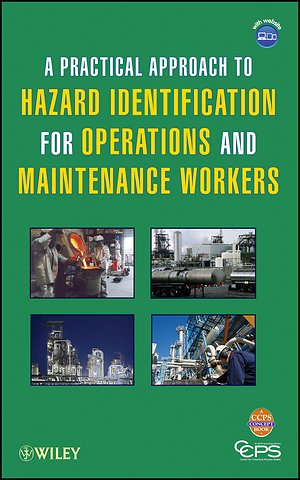A Practical Approach to Hazard Identification for Operations and Maintenance Workers
Samenvatting
The first part of this book (Chapters 1 and 2) provides an introduction and discusses basic concepts.
Chapter 3 deals with the use of the basic human senses for identifying hazards.
Chapter 4 deals with different classes and categories of hazards.
Chapter 5 deals with techniques and methodologies for identifying and evaluating hazards.
Chapter 6 deals with making risk based decisions.
Chapter 7 deals with follow–up and call to action.
Chapter 8 deals with learning and continuous improvement.
The Appendices provide references, case studies, hazard presentations and additional pictures.
Note: CD–ROM/DVD and other supplementary materials are not included as part of eBook file.
Specificaties
Inhoudsopgave
<p>Acknowledgment xiii</p>
<p>Items on CD xv</p>
<p>1 INTRODUCTION i</p>
<p>1.1 Intended Audience 9</p>
<p>1.2 How to Use This Book 11</p>
<p>1.3 References 12</p>
<p>2 BASIC CONCEPTS 13</p>
<p>2.1 Hazard and Risk 14</p>
<p>2.2 Accident Model 16</p>
<p>2.3 Physical and Process Hazards 17</p>
<p>2.4 Benefits of Hazard Identification 34</p>
<p>2.5 Hazards Types by Industry 34</p>
<p>2.6 References 43</p>
<p>3 IDENTIFY HAZARDS 45</p>
<p>3.1 Concept of Recognition 50</p>
<p>3.2 Basic Human Senses 51</p>
<p>3.2.1 Vision 53</p>
<p>3.2.2 Hearing 68</p>
<p>3.2.3 Smell 73</p>
<p>3.2.4 Touch 74</p>
<p>3.2.5 Taste 76</p>
<p>3.3 Relationship Between Senses and Higher Order Processes 76</p>
<p>3.4 Influence of Human Capabilities and Limitations on Hazard Identification 79</p>
<p>3.4.1 Visual Detection 79</p>
<p>3.4.2 Sound Detection 81</p>
<p>3.4.3 Odor Detection 81</p>
<p>3.4.4 Touch Detection 82</p>
<p>3.4.5 Hazard Recognition 82</p>
<p>3.5 What Causes Hazards? 84</p>
<p>3.5.1 Example 1 84</p>
<p>3.5.2 Example 2 87</p>
<p>3.5.3 Example 3 89</p>
<p>3.6 References 90</p>
<p>4 TYPES OF HAZARDS 93</p>
<p>4.1 Explosion Hazards 95</p>
<p>4.1.1 Reactive Explosion Hazards 95</p>
<p>4.1.2 Flammable Explosion Hazards 98</p>
<p>4.1.3 Physical Explosion Hazards 101</p>
<p>4.2 Chemical Hazards 105</p>
<p>4.2.1 Toxic Chemical Hazards 105</p>
<p>4.2.2 Fire Hazards Ill</p>
<p>4.2.3 Corrosive Chemical Hazards 116</p>
<p>4.3 Electrical Hazards 118</p>
<p>4.3.1 Shock/Short Circuit 118</p>
<p>4.3.2 Fire 121</p>
<p>4.3.3 Lightning Strikes 122</p>
<p>4.3.4 Static Electrical Discharge 122</p>
<p>4.3.5 Loss of Power 123</p>
<p>4.4 Excavation Hazards 124</p>
<p>4.5 Asphyxiation Hazards 126</p>
<p>4.6 Elevation Hazards 127</p>
<p>4.7 Thermal Hazards 130</p>
<p>4.7.1 Heat 130</p>
<p>4.7.2 Cold 132</p>
<p>4.8 Vibration Hazards ..132</p>
<p>4.9 Mechanical Failure Hazards 133</p>
<p>4.10 Mechanical Hazards 134</p>
<p>4.11 Corrosion Hazards 135</p>
<p>4.12 Noise Hazards 137</p>
<p>4.13 Radiation Hazards 138</p>
<p>4.13.1 Ionizing Radiation Hazards 138</p>
<p>4.13.2 Non–ionizing Radiation Hazards 139</p>
<p>4.14 Impact Hazards 140</p>
<p>4.15 Struck Against Hazards 142</p>
<p>4.16 Visibility Hazards 143</p>
<p>4.17 Weather Phenomena Hazards 144</p>
<p>4.17.1 Temperature Extreme Hazards 144</p>
<p>4.17.2 Hurricane 147</p>
<p>4.17.3 Flood 147</p>
<p>4.17.4 Wind 149</p>
<p>4.18 References 149</p>
<p>5 EVALUATE HAZARDS 151</p>
<p>5.1 Field Surveys 154</p>
<p>5.1.1 Behavior Observation 154</p>
<p>5.1.2 Facility Walkthrough Checklists 458</p>
<p>5.2 Pre–Job Assessments 164</p>
<p>5.2.1 Job Hazard Analysis 164</p>
<p>5.2.2 Pre–Job Planning and Permitting 175</p>
<p>5.2.3 Ad Hoc Risk Assessment 176</p>
<p>5.3 Facility Assessments 182</p>
<p>5.3.1 Preliminary Hazard Analysis 182</p>
<p>5.3.2 Critical Task Identification Analysis 190</p>
<p>5.4 Incident and Near–Miss Reporting 201</p>
<p>5.4.1 Hazard Trending and Analysis 202</p>
<p>5.4.2 Hazard Mapping 204</p>
<p>5.5 Hazard Identification and Analysis Training 206</p>
<p>5.6 References 207</p>
<p>6 MAKE RISK–BASED DECISIONS 211</p>
<p>6.1 Hazard Ranking 215</p>
<p>6.2 Understanding Risk 217</p>
<p>6.3 Risk Ranking 218</p>
<p>6.3.1 Severity 222</p>
<p>6.3.2 Hierarchy of Safeguards or Layers of Protection 223</p>
<p>6.3.3 Likelihood 228</p>
<p>6.3.4 Risk Ranking 230</p>
<p>6.3.5 Example 1 – Flammable/Explosive Hazard 231</p>
<p>6.3.6 Example 2 – Flammable Hazard 234</p>
<p>6.3.7 More Detailed Matrices 238</p>
<p>6.3.8 Similarities Between More Sophisticated Process Hazard Evaluation Techniques 238</p>
<p>6.4 References 240</p>
<p>7 FOLLOW–UP AND CALL TO ACTION 241</p>
<p>7.1 Safety Culture 242</p>
<p>7.2 Management Commitment 243</p>
<p>7.3 Employee Ownership 243</p>
<p>7.4 Implement an Effective Hazard Management Program 245</p>
<p>7.4.1 Written Procedures and Training 245</p>
<p>7.4.2 Resolving Recommendations for Risk Reduction 245</p>
<p>7.4.3 Concepts to Strengthen Protective Systems 247</p>
<p>7.5 Hazard Communication 249</p>
<p>7.6 Call to Action 251</p>
<p>7.7 References 252</p>
<p>8 LEARNING AND CONTINUOUS IMPROVEMENT 253</p>
<p>8.1 Case Study – Oil Refinery Fire, 2007 253</p>
<p>8.2 Importance of Managing Change 256</p>
<p>8.3 Published Accident Databases and Resources 261</p>
<p>8.4 Revitalizing Lessons Learned 262</p>
<p>8.5 Transfer of Knowledge 263</p>
<p>8.5.1 Identifying and Collecting Information 264</p>
<p>8.5.2 Storing Information 264</p>
<p>8.5.3 Transferring Information 265</p>
<p>8.5.4 Managing the Process 265</p>
<p>8.5.5 Applying What You′ve Learned 265</p>
<p>8.6 Learning from Incidents 267</p>
<p>8.7 References 269</p>
<p>List of Figures 271</p>
<p>List of Tables 277</p>
<p>Index 278</p>

